如何说一口标准美国英语-快速语音纠正法
- 格式:pdf
- 大小:18.85 MB
- 文档页数:44
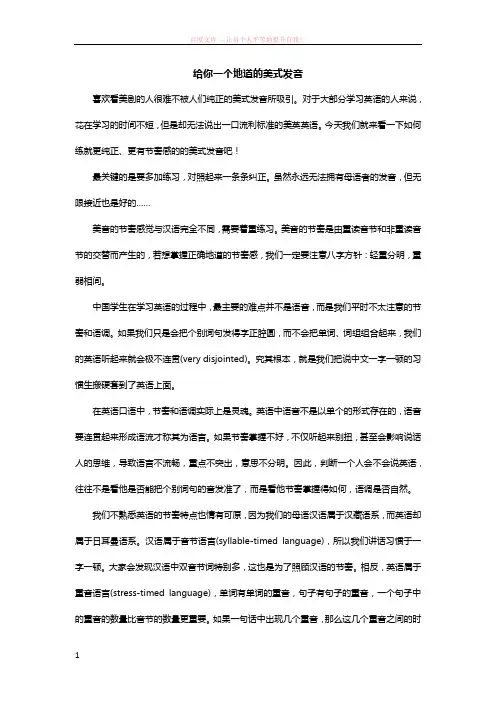
给你一个地道的美式发音喜欢看美剧的人很难不被人们纯正的美式发音所吸引。
对于大部分学习英语的人来说,花在学习的时间不短,但是却无法说出一口流利标准的美英英语。
今天我们就来看一下如何练就更纯正、更有节奏感的的美式发音吧!最关键的是要多加练习,对照起来一条条纠正。
虽然永远无法拥有母语者的发音,但无限接近也是好的……美音的节奏感觉与汉语完全不同,需要着重练习。
美音的节奏是由重读音节和非重读音节的交替而产生的,若想掌握正确地道的节奏感,我们一定要注意八字方针:轻重分明,重弱相间。
中国学生在学习英语的过程中,最主要的难点并不是语音,而是我们平时不太注意的节奏和语调。
如果我们只是会把个别词句发得字正腔圆,而不会把单词、词组组合起来,我们的英语听起来就会极不连贯(very disjointed)。
究其根本,就是我们把说中文一字一顿的习惯生搬硬套到了英语上面。
在英语口语中,节奏和语调实际上是灵魂。
英语中语音不是以单个的形式存在的,语音要连贯起来形成语流才称其为语言。
如果节奏掌握不好,不仅听起来别扭,甚至会影响说话人的思维,导致语言不流畅,重点不突出,意思不分明。
因此,判断一个人会不会说英语,往往不是看他是否能把个别词句的音发准了,而是看他节奏掌握得如何,语调是否自然。
我们不熟悉英语的节奏特点也情有可原,因为我们的母语汉语属于汉藏语系,而英语却属于日耳曼语系。
汉语属于音节语言(syllable-timed language),所以我们讲话习惯于一字一顿。
大家会发现汉语中双音节词特别多,这也是为了照顾汉语的节奏。
相反,英语属于重音语言(stress-timed language),单词有单词的重音,句子有句子的重音,一个句子中的重音的数量比音节的数量更重要。
如果一句话中出现几个重音,那么这几个重音之间的时间距离大致相等。
所以,重读音节感觉上可以读得慢一些,而弱读音节就可以一带而过。
由此可见句子节奏和时间长短(length of time)不可分开。
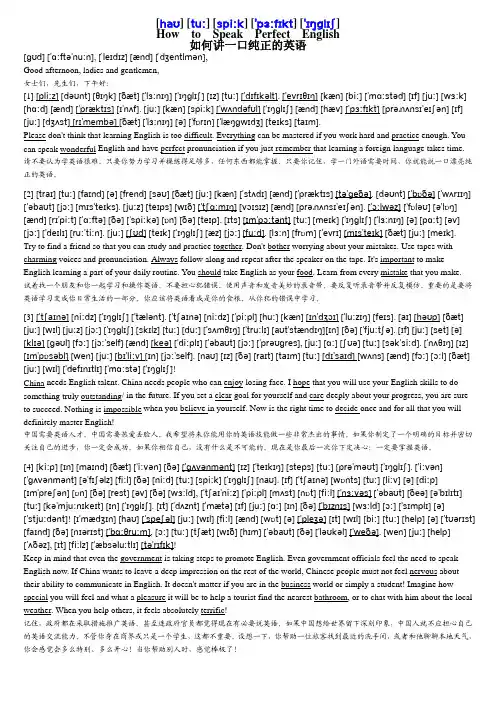
[haJ] [tu:] [spi:k] [5p\:fIkt] [5IN^lIF]How to Speak Perfect English如何讲一口纯正的英语[^Jd] [5B:ftE5nu:n], [`leIdIz] [And] [`dVentlmEn],Good afternoon, ladies and gentlemen,女士们,先生们,下午好:[1] [pli:z] [dEJnt] [WINk] [TAt] [5l\:nIN] [5IN^lIF] [Iz] [tu:] [5dIfIkElt]. [5evrIWIN] [kAn] [bi:] [5mB:stEd] [If] [ju:] [w\:k] [hB:d] [And] [5prAktIs] [I5nQf]. [ju:] [kAn] [spi:k] [5wQndEfJl] [5IN^lIF] [And] [hAv] [5p\:fIkt] [prE7nQnsI5eIFEn] [If] [ju:] [dVQst] [rI5membE] [TAt] [5l\:nIN] [E] [5fDrIn] [5lAN^wIdV] [teIks] [taIm].Please don't think that learning English is too difficult. Everything can be mastered if you work hard and practice enough. You can speak wonderful English and have perfect pronunciation if you just remember that learning a foreign language takes time.请不要认为学英语很难。
只要你努力学习并操练得足够多,任何东西都能掌握。
只要你记住,学一门外语需要时间,你就能说一口漂亮纯正的英语。
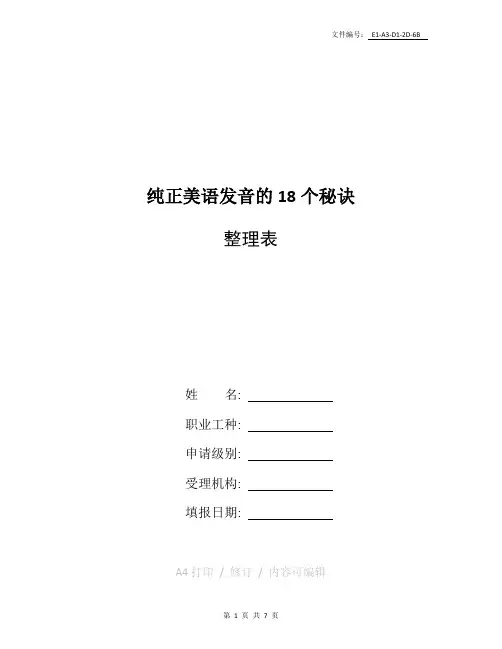
纯正美语发音的18个秘诀整理表姓名:职业工种:申请级别:受理机构:填报日期:A4打印/ 修订/ 内容可编辑社交礼仪第一次作业一单项选择1、对外人称自己的家人,加()是用来称呼比自己辈分高或年长的家长。
A、大B、家C、舍2、介绍集体时,应注意的顺序是()。
A、熟人B、负责人的身份为准C、女士3、俄罗斯人的姓名由三个部分构成,首为( ) ,次为父名,末为姓氏。
A、本名B、妻名C、母名4、居中介绍中哪项规则是错误的()。
A 尊者优先了解情况B 先将女士介绍给男士C 先将职位低的介绍给职位高的D 先将年轻的介绍给年长的5、介绍他人或为他人指示方向时的手势应该用()。
A食指 B拇指 C掌心向上 D掌心向下6、在介绍两人相识时,总的规矩是( )A.先卑后尊B.先尊后卑C.先女后男D.先主后宾7、握手的全部时间应控制在()秒钟以内。
A、1秒钟B、3秒种C、5秒钟D、7秒钟8、男子与妇女握手时,应只轻轻握一下妇女的CA.指尖B.手掌C.手指 D 手腕9、名片交换顺序正确的有()。
A客先主后 B 身份低着先 C 身份高者先 D 主先客后10、呈递名片中不正确的说法是()。
A 只能用右手呈递B 要将名片正面朝向接受方C接受的名片应放到名片夹或上衣口袋中11、看过别人名片后,应将名片放在()。
A 桌子上B 裤袋里C 包里D 西装左胸内衣袋13、友善式握手是指手掌()。
A、手掌向下B、手掌向上C、手掌垂直于地面14、双手相握不适宜( )。
A、女士或初次相识者B、亲朋好友C、老朋友15、行握手礼时,礼貌的伸手方式是伸出右手()。
A手掌与地面垂直B、掌心向下倾斜C、随意D手掌向上倾斜16、握手的标准方式,是行礼时行至距握手对象约( ) 米处。
A、1米B、0.5米C、1.5米17、普通场合的拜会时间应控制在()A、一小时B、半小时C、2小时18、在交谈中一个人的每次发言,最好不要长于()A、5分钟B、3分钟C、10分钟19、礼仪是一个人性格、()、文化程度、道德修养的外化。
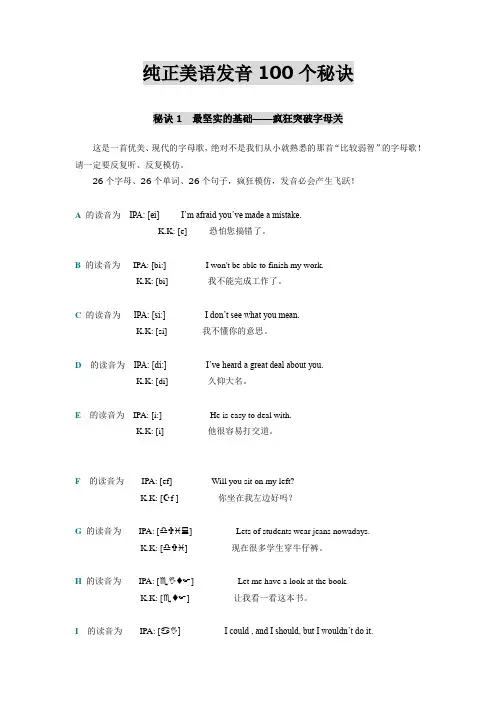
纯正美语发音100个秘诀秘诀1 最坚实的基础——疯狂突破字母关这是一首优美、现代的字母歌,绝对不是我们从小就熟悉的那首“比较弱智”的字母歌!请一定要反复听、反复模仿。
26个字母、26个单词、26个句子,疯狂模仿,发音必会产生飞跃!A的读音为IPA: [ei] I’m afraid you’ve made a mistake.K.K: [e] 恐怕您搞错了。
B的读音为IPA: [bi:] I won't be able to finish my work.K.K: [bi] 我不能完成工作了。
C的读音为IPA: [si:] I don’t see what you mean.K.K: [si] 我不懂你的意思。
D的读音为IPA: [di:] I’ve heard a great deal about you.K.K: [di] 久仰大名。
E的读音为IPA: [i:] He is easy to deal with.K.K: [i] 他很容易打交道。
F的读音为IPA: [ef] Will you sit on my left?K.K: [☪f ] 你坐在我左边好吗?G的读音为IPA: [♎✞♓] Lets of students wear jeans nowadays.K.K: [♎✞♓] 现在很多学生穿牛仔裤。
H的读音为IPA: [♏✋♦☞] Let me have a look at the book.K.K: [♏♦☞] 让我看一看这本书。
I的读音为IPA: [♋✋] I could , and I should, but I wouldn’t do it.K.K: [♋✋] 这个我能做,我也应该做,但是我不愿意做。
J的读音为IPA: [♎✞♏✋] He was jailed for two years.K.K: [♎✞♏] 他被囚禁了两年。
K的读音为IPA: [ ♏✋] In any case, it’s none of your business.K.K: [ ♏] 无论如何,那事与你无关。
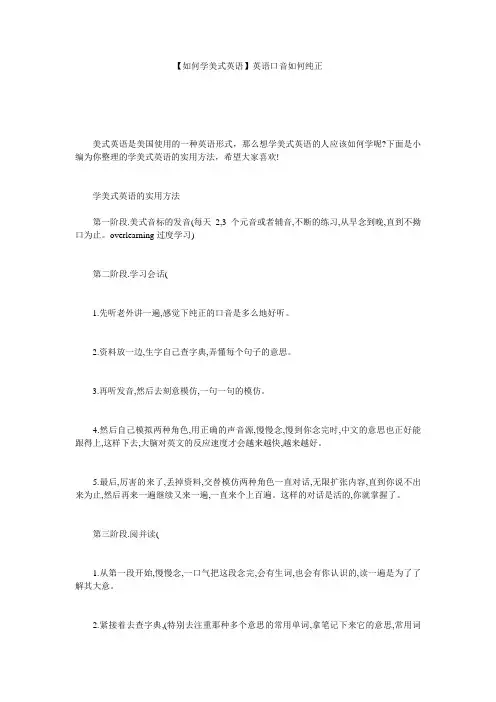
【如何学美式英语】英语口音如何纯正美式英语是美国使用的一种英语形式,那么想学美式英语的人应该如何学呢?下面是小编为你整理的学美式英语的实用方法,希望大家喜欢!学美式英语的实用方法第一阶段.美式音标的发音(每天2,3个元音或者辅音,不断的练习,从早念到晚,直到不拗口为止。
overlearning过度学习)第二阶段.学习会话(1.先听老外讲一遍,感觉下纯正的口音是多么地好听。
2.资料放一边,生字自己查字典,弄懂每个句子的意思。
3.再听发音,然后去刻意模仿,一句一句的模仿。
4.然后自己模拟两种角色,用正确的声音源,慢慢念,慢到你念完时,中文的意思也正好能跟得上,这样下去,大脑对英文的反应速度才会越来越快,越来越好。
5.最后,厉害的来了,丢掉资料,交替模仿两种角色一直对话,无限扩张内容,直到你说不出来为止,然后再来一遍继续又来一遍,一直来个上百遍。
这样的对话是活的,你就掌握了。
第三阶段.阅并读(1.从第一段开始,慢慢念,一口气把这段念完,会有生词,也会有你认识的,读一遍是为了了解其大意。
2.紧接着去查字典,(特别去注重那种多个意思的常用单词,拿笔记下来它的意思,常用词组以及怎么应用在句子里的),都查完后,然后自己再把它翻译一遍。
3.底下就是朗读这一段广播,慢慢念,越慢越好,慢到你的中文翻译和你的英文的速度是一致的,不断地练,反复地练,等熟了后,这种一致性的速度自然而然就跟上去了。
4.到了这里还没有结束,丢掉这则广播,自己用英文讲,你刚才看到的这一段广播讲的是什么内容,一遍讲不好,再去讲第二遍,第三遍。
乃至上百遍5.结果,单词全部是用声音记忆在你脑子里了。
后面慢慢扩大到两小段,接着一整篇广播,最后用这种方式,看好多的广播,再丢掉,再用英文去诠释,去表达。
不知不觉,你要讲多久英文,你就可以讲多久的英文。
美式英语学习方法一、找一个专业的网站想要学习纯正的美式英语,就必须得找一个专业的网站。
网上学习英语有很多的网站,但是由于发音的不同,作为学生的我们是很难辨别这些英语发音的,必要的时候还是得别人进行指导,这样说出来的英语才知道是不是美式英语。
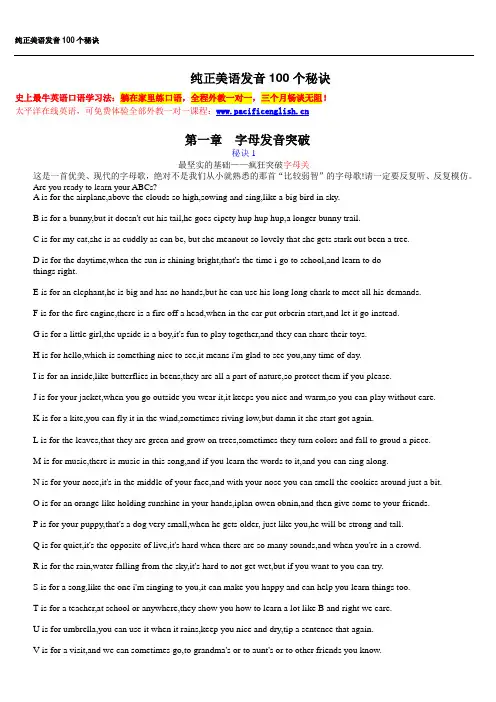
纯正美语发音100个秘诀史上最牛英语口语学习法:躺在家里练口语,全程外教一对一,三个月畅谈无阻!太平洋在线英语,可免费体验全部外教一对一课程:第一章字母发音突破秘诀1最坚实的基础——疯狂突破字母关这是一首优美、现代的字母歌,绝对不是我们从小就熟悉的那首“比较弱智”的字母歌!请一定要反复听、反复模仿。
Are you ready to learn your ABCs?A is for the airplane,above the clouds so high,sowing and sing,like a big bird in sky.B is for a bunny,but it doesn't cut his tail,he goes cipety hup hup hup,a longer bunny trail.C is for my cat,she is as cuddly as can be, but she meanout so lovely that she gets stark out been a tree.D is for the daytime,when the sun is shining bright,that's the time i go to school,and learn to dothings right.E is for an elephant,he is big and has no hands,but he can use his long long chark to meet all his demands.F is for the fire engine,there is a fire off a head,when in the car put orberin start,and let it go instead.G is for a little girl,the upside is a boy,it's fun to play together,and they can share their toys.H is for hello,which is something nice to see,it means i'm glad to see you,any time of day.I is for an inside,like butterflies in beens,they are all a part of nature,so protect them if you please.J is for your jacket,when you go outside you wear it,it keeps you nice and warm,so you can play without care.K is for a kite,you can fly it in the wind,sometimes riving low,but damn it she start got again.L is for the leaves,that they are green and grow on trees,sometimes they turn colors and fall to groud a piece.M is for music,there is music in this song,and if you learn the words to it,and you can sing along.N is for your nose,it's in the middle of your face,and with your nose you can smell the cookies around just a bit.O is for an orange like holding sunshine in your hands,iplan owen obnin,and then give some to your friends.P is for your puppy,that's a dog very small,when he gets older, just like you,he will be strong and tall.Q is for quiet,it's the opposite of live,it's hard when there are so many sounds,and when you're in a crowd.R is for the rain,water falling from the sky,it's hard to not get wet,but if you want to you can try.S is for a song,like the one i'm singing to you,it can make you happy and can help you learn things too.T is for a teacher,at school or anywhere,they show you how to learn a lot like B and right we care.U is for umbrella,you can use it when it rains,keep you nice and dry,tip a sentence that again.V is for a visit,and we can sometimes go,to grandma's or to aunt's or to other friends you know.W is a welcome,that's what i like say,when friends come to my house it means come on in and play.X is for a xenophon,it's an instrument you know,or you can use an X when you play take-tatoo.Y is for you,that's the person that you are,to me and all your friends,and we hope that you go far.Z is for zoo,lots of animals to see,and everyone is very special,just like you and me.And now you learn your ABCs,have fun, good这是一首优美、现代的字母歌,绝对不是我们从小就熟悉的那首“比较弱智”的字母歌!请一定要反复听、反复模仿。
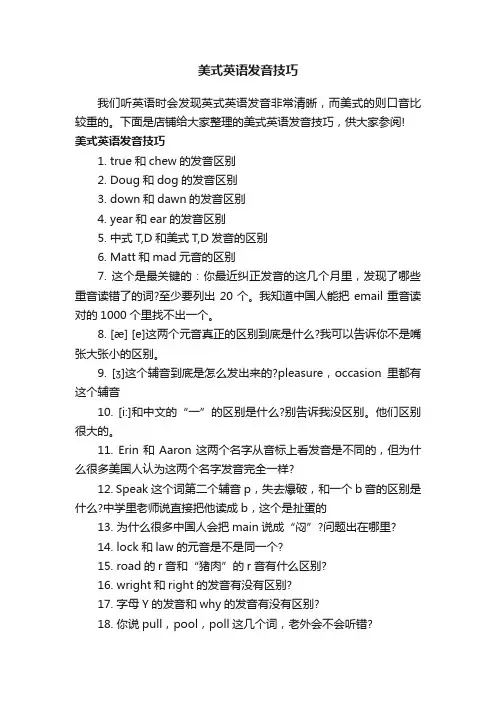
美式英语发音技巧我们听英语时会发现英式英语发音非常清晰,而美式的则口音比较重的。
下面是店铺给大家整理的美式英语发音技巧,供大家参阅! 美式英语发音技巧1. true和chew的发音区别2. Doug和dog的发音区别3. down和dawn的发音区别4. year和ear的发音区别5. 中式T,D和美式T,D发音的区别6. Matt和mad元音的区别7. 这个是最关键的:你最近纠正发音的这几个月里,发现了哪些重音读错了的词?至少要列出20个。
我知道中国人能把email重音读对的1000个里找不出一个。
8. [æ] [e]这两个元音真正的区别到底是什么?我可以告诉你不是嘴张大张小的区别。
9. [ʒ]这个辅音到底是怎么发出来的?pleasure,occasion里都有这个辅音10. [i:]和中文的“一”的区别是什么?别告诉我没区别。
他们区别很大的。
11. Erin和Aaron这两个名字从音标上看发音是不同的,但为什么很多美国人认为这两个名字发音完全一样?12. Speak这个词第二个辅音p,失去爆破,和一个b音的区别是什么?中学里老师说直接把他读成b,这个是扯蛋的13. 为什么很多中国人会把main说成“闷”?问题出在哪里?14. lock和law的元音是不是同一个?15. road的r音和“猪肉”的r音有什么区别?16. wright和right的发音有没有区别?17. 字母Y的发音和why的发音有没有区别?18. 你说pull,pool,poll这几个词,老外会不会听错?美式英语发音方法首先,美式发音中的r,是一个标志。
在美语中,字母R就从来没有不发音的。
而在英式英语,澳洲英语中常常是不震动声带发音的。
在美式发音中,字母R相当一个卷舌音的发音标志。
它在下面几种情况下会出现:第一,当字母R出现在最后一个字母位置的时候,要发卷舌音。
比如:teacher,car,four第二,当字母R的后面紧跟一个辅音字母的时候,这里的R要发音/r/,比如heard,learn美式发音中的第二个特征,是关于美式浊化音。
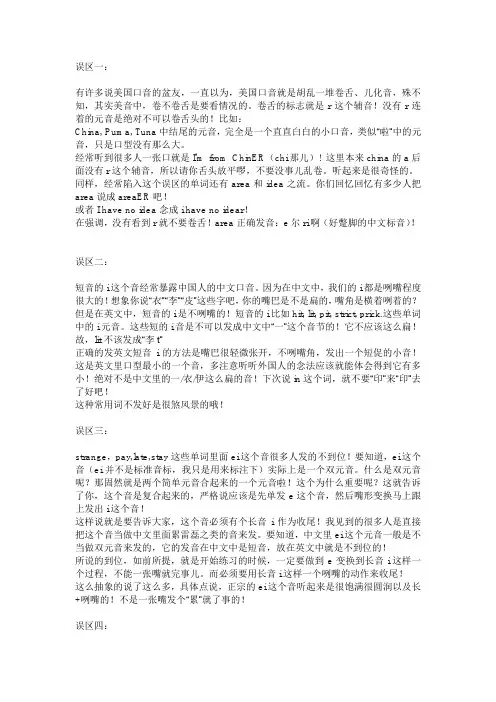
误区一:有许多说美国口音的盆友,一直以为,美国口音就是胡乱一堆卷舌、儿化音,殊不知,其实美音中,卷不卷舌是要看情况的。
卷舌的标志就是r这个辅音!没有r连着的元音是绝对不可以卷舌头的!比如:China, Puma, Tuna中结尾的元音,完全是一个直直白白的小口音,类似“啦”中的元音,只是口型没有那么大。
经常听到很多人一张口就是I'm from ChinER(chi那儿)! 这里本来china的a后面没有r这个辅音,所以请你舌头放平啰,不要没事儿乱卷。
听起来是很奇怪的。
同样,经常陷入这个误区的单词还有area和idea之流。
你们回忆回忆有多少人把area说成areaER吧!或者I have no idea念成i have no idear!在强调,没有看到r就不要卷舌!area正确发音:e尔ri啊(好蹩脚的中文标音)!误区二:短音的i这个音经常暴露中国人的中文口音。
因为在中文中,我们的i都是咧嘴程度很大的!想象你说“衣”“李”“皮”这些字吧,你的嘴巴是不是扁的,嘴角是横着咧着的?但是在英文中,短音的i是不咧嘴的!短音的i比如hit, lit, pit, strict, prick.这些单词中的i元音。
这些短的i音是不可以发成中文中“一”这个音节的!它不应该这么扁!故,lit不该发成“李t”正确的发英文短音i的方法是嘴巴很轻微张开,不咧嘴角,发出一个短促的小音!这是英文里口型最小的一个音,多注意听听外国人的念法应该就能体会得到它有多小!绝对不是中文里的一/衣/伊这么扁的音!下次说in这个词,就不要“印”来“印”去了好吧!这种常用词不发好是很煞风景的哦!误区三:strange,pay,late,stay这些单词里面ei这个音很多人发的不到位!要知道,ei这个音(ei并不是标准音标,我只是用来标注下)实际上是一个双元音。
什么是双元音呢?那固然就是两个简单元音合起来的一个元音啦!这个为什么重要呢?这就告诉了你,这个音是复合起来的,严格说应该是先单发e这个音,然后嘴形变换马上跟上发出i这个音!这样说就是要告诉大家,这个音必须有个长音i作为收尾!我见到的很多人是直接把这个音当做中文里面累雷磊之类的音来发。
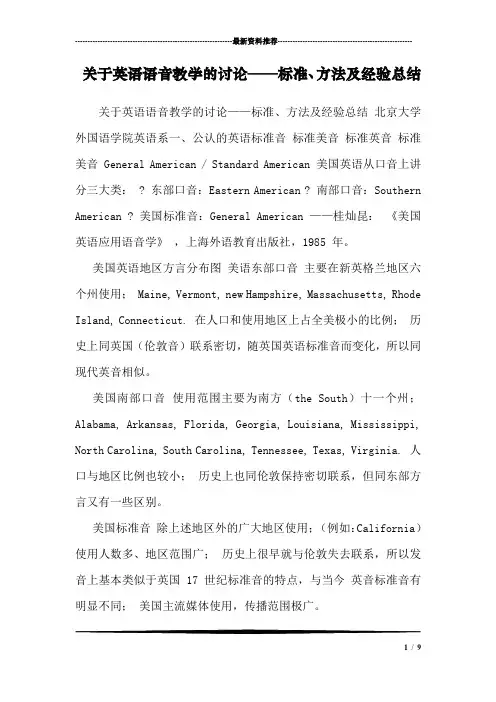
---------------------------------------------------------------最新资料推荐------------------------------------------------------ 关于英语语音教学的讨论——标准、方法及经验总结关于英语语音教学的讨论——标准、方法及经验总结北京大学外国语学院英语系一、公认的英语标准音标准美音标准英音标准美音 General American / Standard American 美国英语从口音上讲分三大类: ? 东部口音:Eastern American ? 南部口音:Southern American ? 美国标准音:General American ——桂灿昆:《美国英语应用语音学》,上海外语教育出版社,1985 年。
美国英语地区方言分布图美语东部口音主要在新英格兰地区六个州使用; Maine, Vermont, new Hampshire, Massachusetts, Rhode Island, Connecticut. 在人口和使用地区上占全美极小的比例;历史上同英国(伦敦音)联系密切,随英国英语标准音而变化,所以同现代英音相似。
美国南部口音使用范围主要为南方(the South)十一个州;Alabama, Arkansas, Florida, Georgia, Louisiana, Mississippi, North Carolina, South Carolina, Tennessee, Texas, Virginia. 人口与地区比例也较小;历史上也同伦敦保持密切联系,但同东部方言又有一些区别。
美国标准音除上述地区外的广大地区使用;(例如:California)使用人数多、地区范围广;历史上很早就与伦敦失去联系,所以发音上基本类似于英国 17 世纪标准音的特点,与当今英音标准音有明显不同;美国主流媒体使用,传播范围极广。
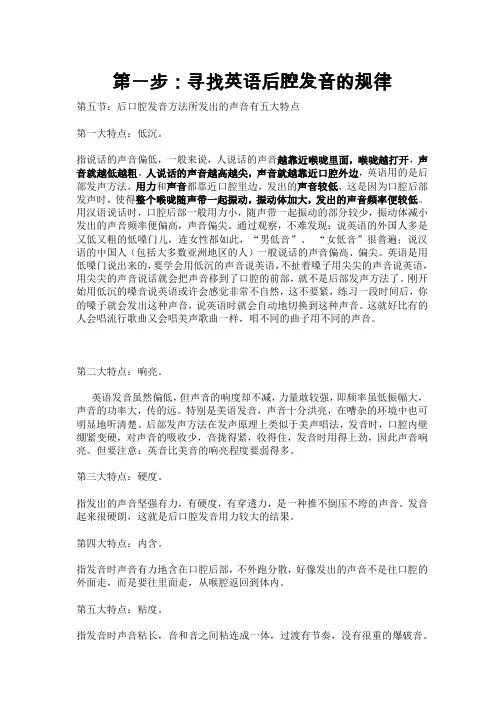
第一步:寻找英语后腔发音的规律第五节:后口腔发音方法所发出的声音有五大特点第一大特点:低沉。
指说话的声音偏低,一般来说,人说话的声音越靠近喉咙里面,喉咙越打开,声音就越低越粗。
人说话的声音越高越尖,声音就越靠近口腔外边,英语用的是后部发声方法,用力和声音都靠近口腔里边,发出的声音较低,这是因为口腔后部发声时,使得整个喉咙随声带一起振动,振动体加大,发出的声音频率便较低。
用汉语说话时,口腔后部一般用力小,随声带一起振动的部分较少,振动体减小发出的声音频率便偏高,声音偏尖。
通过观察,不难发现:说英语的外国人多是又低又粗的低嗓门儿,连女性都如此,“男低音”、“女低音”很普遍;说汉语的中国人(包括大多数亚洲地区的人)一般说话的声音偏高、偏尖。
英语是用低嗓门说出来的,要学会用低沉的声音说英语,不扯着嗓子用尖尖的声音说英语,用尖尖的声音说话就会把声音移到了口腔的前部,就不是后部发声方法了。
刚开始用低沉的嗓音说英语或许会感觉非常不自然,这不要紧,练习一段时间后,你的嗓子就会发出这种声音,说英语时就会自动地切换到这种声音。
这就好比有的人会唱流行歌曲又会唱美声歌曲一样,唱不同的曲子用不同的声音。
第二大特点:响亮。
英语发音虽然偏低,但声音的响度却不减,力量敢较强,即频率虽低振幅大,声音的功率大,传的远。
特别是美语发音,声音十分洪亮,在嘈杂的环境中也可明显地听清楚。
后部发声方法在发声原理上类似于美声唱法,发音时,口腔内壁绷紧变硬,对声音的吸收少,音拢得紧,收得住,发音时用得上劲,因此声音响亮。
但要注意:英音比美音的响亮程度要弱得多。
第三大特点:硬度。
指发出的声音坚强有力,有硬度,有穿透力,是一种推不倒压不垮的声音。
发音起来很硬朗,这就是后口腔发音用力较大的结果。
第四大特点:内含。
指发音时声音有力地含在口腔后部,不外跑分散,好像发出的声音不是往口腔的外面走,而是要往里面走,从喉腔返回到体内。
第五大特点:粘度。
指发音时声音粘长,音和音之间粘连成一体,过渡有节奏,没有很重的爆破音。
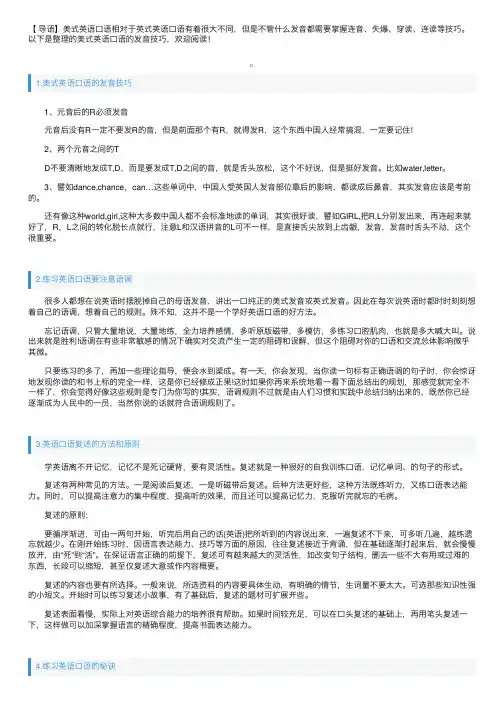
【导语】美式英语⼝语相对于英式英语⼝语有着很⼤不同,但是不管什么发⾳都需要掌握连⾳、失爆、穿读、连读等技巧。
以下是整理的美式英语⼝语的发⾳技巧,欢迎阅读!1.美式英语⼝语的发⾳技巧 1、元⾳后的R必须发⾳ 元⾳后没有R⼀定不要发R的⾳,但是前⾯那个有R,就得发R,这个东西中国⼈经常搞混,⼀定要记住! 2、两个元⾳之间的T D不要清晰地发成T,D,⽽是要发成T,D之间的⾳,就是⾆头放松,这个不好说,但是挺好发⾳。
⽐如water,letter。
3、譬如dance,chance,can…这些单词中,中国⼈受英国⼈发⾳部位靠后的影响,都读成后⿐⾳,其实发⾳应该是考前的。
还有像这种world,girl,这种⼤多数中国⼈都不会标准地读的单词,其实很好读,譬如GIRL,把R,L分别发出来,再连起来就好了,R,L之间的转化脱长点就⾏,注意L和汉语拼⾳的L可不⼀样,是直接⾆尖放到上齿龈,发⾳,发⾳时⾆头不动,这个很重要。
2.练习英语⼝语要注意语调 很多⼈都想在说英语时摆脱掉⾃⼰的母语发⾳,讲出⼀⼝纯正的美式发⾳或英式发⾳。
因此在每次说英语时都时时刻刻想着⾃⼰的语调,想着⾃⼰的规则。
殊不知,这并不是⼀个学好英语⼝语的好⽅法。
忘记语调,只管⼤量地说,⼤量地练,全⼒培养感情,多听原版磁带,多模仿,多练习⼝腔肌⾁,也就是多⼤喊⼤叫。
说出来就是胜利!语调在有些⾮常敏感的情况下确实对交流产⽣⼀定的阻碍和误解,但这个阻碍对你的⼝语和交流总体影响微乎其微。
只要练习的多了,再加⼀些理论指导,便会⽔到渠成。
有⼀天,你会发现,当你读⼀句标有正确语调的句⼦时,你会惊讶地发现你读的和书上标的完全⼀样,这是你已经修成正果!这时如果你再来系统地看⼀看下⾯总结出的规划,那感觉就完全不⼀样了,你会觉得好像这些规则是专门为你写的!其实,语调规则不过就是由⼈们习惯和实践中总结归纳出来的,既然你已经逐渐成为⼈民中的⼀员,当然你说的话就符合语调规则了。
秘诀26How about you?Take care that you don’t spoil your new clothes.A: I’m very glad to meet you.B: It’s a pleasure to meet you.I’m sorry to tell that you’ve been dismissed.秘诀27Could you tell me where the bus stop is?A: Did you panic?B: Of course! It was awful!Would you show me the bathroom, please?Would you care to go for a walk with me? (Care of 想)Could you do me a favor?Could you possibly give me a lift home? 你能让我搭个便车回家吗?秘诀28因发音部位的影响而发生的同化this shipHas she come?He tell you the truth.秘诀29Thank you.I take a walk along the river bank every morning.I think I can learn to speak good English in one month.Hunger is best sauce.He hungered for her love.I was angered by his refusal to come to the party.秘诀30He lives by his pen.All of his dealings are in the open.Let’s be open with each other.I want you to be open with me about your money problems, so I can help you. Do you happen to know his new telephone number?秘诀31]ΩρXνnorth [ ]νΛTρXν⎺northern []νΛTΘσ⎺] southern [ ΩυBσsouth []Ω*ωworth [ ]IT*ω⎺worthy [She has traveled in northern countries.The southern half of the country is a desert.She says help only the worthy poor.This book is worthy of being read [ to be read ].秘诀32spendHow do you spend you leisure? 你是怎样消磨空闲时间的。
英语口语完美发音的10个窍门英语口语完美发音的10个窍门引导语:学英语的很多人最大的难点不是记单词,也不是语法,反而是口语发音,因为没什么机会和外国人交流,发音会越来越差。
那么,英语口语完美发音有什么窍门?以下店铺为你分享关于英语口语完美发音的10个窍门:1. Listen to yourself. 倾听自己很多同学苦于自己发音不准,矫正自身发音的前提就是分辨自己语音中的错误。
怎么破?推荐给大家的方法是:把自己的发音录下来,然后和源音音频进行对照。
2. Copy the experts. 模仿正宗发音仔细听英语广播节目并看英语的电视节目和动画片。
模仿你所听到的-就算你还不肯定他们说的话。
3. Practice makes perfect. 熟能生巧发音的问题迟迟不能解决就是因为我们害怕犯错。
—第一次见面、在饭店点菜、询问方向——你可以自己表演出对话内容。
4.Find a language buddy. 找一个一起的小伙伴从其他人处获得反馈是非常重要的。
找一个对提高英语水平同样感兴趣的朋友。
试着更换录音资料这样你就可以互相听对方的`发音。
记住录完要重新听听,找出错误和闪光点啊。
5. Be poetic. 要讲究韵律好的发音不仅是掌握单独的音节。
还是对intonation (声音的升降调)和stress (对单词中一些音节和句子中的一些单词更大声更清晰的发音)的理解。
大声念一些诗歌,演讲,歌曲,集中练习单词的重音和音调。
6. Sing a song!唱英文歌英文歌学英语。
用此法练习自己的听力,积累词汇,夯实语法。
一首好的、经典的英文儿歌,在遣词构句、旋律以及发音上面是很有讲究的。
7.Slow down! 慢下来世间武功,唯快不破。
看到很多人快速飚英语时是很眼馋的。
但是记住,英语说的慢比说的快要难。
很多英语学习者常说语速太快容易养成坏习惯。
由于太快而模糊不清是口语考试的一大坏毛病。
所以我们要accuracy 然后才是fluency,每天操练一些基本语言以单音节开始,然后单词,最后把几个词连在一起组成句子。
美语发音秘诀美语发音秘诀- -附1:/D/舌头轻点一下上颚,类似汉语拼音的/d/,或K.K.音标的/d/,但不是随便地把/d/这个音发出来,而是用舌头碰一下上颚,带出下一个音。
附2:'-'表示前后两个词要连读,所以音节被拆开,发音的时候不再以原来的单词为单位,而以连读产生的新音节为准。
连读两原则:辅音接辅音时,元音会接收前词词尾的辅音。
辅音接辅音时,前词词尾辅音消音,只念后词辅音词尾。
1、三个基本句型的口语读法be going to -- be gonnawant to -- wannahave got to -- ('ve) gotta2、重音变轻音(句子中次要单词的元音要弱读)3、后元接前辅(连着的两个单词,前面的单词词尾的辅音会和后面单词词首的原因产生连读)2、重音变轻音(句子中次要单词的元音要弱读)3、后元接前辅(连着的两个单词,前面的单词词尾的辅音会和后面单词词首的原因产生连读)4、y的变音(以/t/,/d/,/s/,/z/结尾的单词接以字母y开头的单词,会产生连读)5、轻辅变浊辅(以/t/结尾的单词碰上以元音开头的单词,发音会有变化)6、不发音的辅音(在一些情况下,前面单词的词尾辅音遇上后面以辅音开头的1/15页单词时,前面单词词尾的辅音不发音。
)7、h不发音(当he、him、his、her与前面单词连读时,/h/不发音;have的/h/不发音;where、what、when、which当中的/h/不发音)1、of的连读现象of后接辅音,f不发音,of后接元音,就与元音连读2、t的连读现象t与后面的元音连读时,就会念做轻/D/在字尾的t与不能连读的辅音相连时,不发音。
-ing在自然语速下的读法-ing在自然语速下的发音方法,称为'喉音'glottal stop。
发这个音的诀窍是将舌头顶在上颚(上排牙齿后方),由喉咙吐气发音,不过不是直接地吐气,而是顶出闷闷的声音来。
英语心得说和听只要我听得懂别人说的话和别人听得懂我说的话,说的时候。
所以,就要我发的音跟老外发的音是一样的。
正确发音的方法步骤:1.熟练每个音标的发音,每个音标在口腔中是如何发音的,舌头的位置怎么样、动作怎么样、口型怎么样的2.当这些各个音标出现在一个单词的时候,正确发音就是口型+舌头的动作+舌头的位置。
啊,原来这就是所谓的“韵律”英语发音:有的单词,它一个单词,就有多个音节,在一个单词里面,有的音节说得快一点,有的音节说得慢一点,有的音节说得强一点(清晰一点),有的音节说得弱一点(音量低一点)。
连音还有,“连音”,“后母接前子”,需要连音的地方,连音后,那个混合的音节是比较弱一点,音量低一点的。
听别人说话,就是辨别这些音节,这些音节的调调高高低低,快快慢慢,就形成了所谓的“韵律”,像唱歌一样的。
这些特质一方面是反映了说话人的语气,语气背后是他的态度啊、情绪啊等等。
我们在学校学的英文,听的是字正腔圆的每个音节都清清楚楚地发音,就像外国人学普通话,他们听着教材里面的标准普通话的语气语调,就跟我们听着英语教材里面的字正腔圆的英语一样。
教材里的语言,为了正确和客观,就得灭掉情绪,以最客观的口气来说话。
但日常生活中,情绪不同,音节的强强弱弱、高高低低,快快慢慢,这跟我们听教材或者考试的英语录音是完全不一样的啊。
想象一下,普通话在教材上和生活日用上的差异就明白了。
所以,我们要懂得分辨这些不同的音节组合在一起的时候的意思。
语调准则1.不要逐字发音(逐字发音的示范Bob is on the phone):逐字发音会显得很呆板也不地道,这跟正常会话的语调有很大的差别的。
要按音群去说2.连接单词,形成音群,按音群去说(按音群去说的示范Bob is on the phone)说英语的时候,不要把每个单词作为一个单位,而要把音群作为单位。
音群可能与页面上的一个单词对应,也可能不对应。
说英语母语的人会连音说“Bob is on the phone”不会一个字一个字说的。
美语语音、语调、节奏速成法则——如何在三个月内练成纯正美音?作者简介:上海新东方学校著名语音、口语、口译教学专家。
高级同声翻译。
复旦英语语言文学硕士,曾进修于美国BELOIT COLLEGE。
主讲听说特训、听说速成、中/高级口译等。
引言:“天行健,君子自强不息”。
英语学习亦是如此。
在完善英语综合实力的荆棘之路上,语音训练需要迈好坚实的第一步。
练习语音不仅要有完备的理论知识,还要有恒久磨练的决习与毅力。
许多同学都抱着壮士扼腕的决心来读新东方的美语语音速成班,可是往往觉得条理清晰了很多,发音还是怎么都拗不过来。
其实语音练习是一种打破旧习惯、建立新习惯的过程,关键就在于不间断的外界刺激,以形成条件反射,从自发到自觉发出地道的美语发音。
对于一名英语水平中等的学生来说,如其欲练就一口地道的美语语音的决心牢不可捍,同时可以保证投入练习的时间与精力,加上适当方法的指导,三个月内成就纯正的语音语调绝不是遥不可及的梦想!以下我们就介绍一下如何系统地、有计划有目的地练习美语语音、语调与节奏。
一.整合语音体系法著名应用语言学家克拉申(Krashen)在上世纪70年代就提出一假说,对二语学习者而言,大量可理解的输入信息(comprehensible input)能够使他们在知识系统中更快地建立起目标语的体系。
这一假说实际上就奠定了听力理解在二语习得过程中不可或缺的地位。
但是,由于大多数中国的英语学习者缺乏系统的语音知识,导致他们说出的英语不地道,最重要的是地道的英语他们挺不懂。
整合语音体系成为迅速突破英语学习瓶颈的切入点。
大多数中国学生在数年的英语学习过程中零零散散地都接触过语音知识,对于英式发音与美式发音的一般具有模糊的感性认识。
但是如果我们想有目的、系统性地精粹发音纯度,就必须将感性认识升华至理性高度,此时整合语音知识,建立语音体系就成为不可或缺的步骤。
例如,新东方的美语语音速成班就会像学员系统介绍英音与美音的区别,美音辅音[t]的八条发音规则,四大同化原则,四大连读原则,美语弱读与缩读,七大英语句式的语调体现,语调变调的含义等等板块,不一而足。
[i:]该音是个前元音,是字母ea,ee,ie或ei在单词中的发音。
此音是长元音,一定注音把音发足。
其发音要领是发音时舌尖抵下齿,前舌尽量抬高、舌位高于/i/,口形扁平。
李阳疯狂发音秘诀:1.发音时,上下唇微开,嘴唇扁平。
2.上下齿分开,距离约能容纳一个火柴棍。
3.舌部及下颚肌肉紧张,舌尖抵下齿,舌前部向硬颚尽量抬起。
4.嘴角尽量往两边移动,像微笑的样子。
所以英美人拍照时喜欢说“cheess”。
5.在发音的时候要尽量拉长,就像古人喝醉酒以后吟诗的感觉。
要记住:饱满的长元音是漂亮英语的秘诀。
6.这个音非常容易同汉语里“一”搞混,要注意:“一”的发音实际上是/ji/,是以半元音/j/开头的,而我们学的这个“长衣音”是直接以元音开始的。
7.常发这个元音的有:字母e、字母组合ee、ea、ie、ei.8.美语中以“y”结尾的单词“y”也发成“长衣音”,这一点跟英式英语中是有区别的,要注意。
[i]该音是个前元音,是字母i或y在重读闭音中的读音。
它是个短元音,故发此音要短促而轻快。
发音要领的是:舌尖抵下齿,舌前部抬高,舌两侧抵上齿两侧,口形偏平。
李阳疯狂发音秘诀:1.发音时,口形扁平,嘴唇稍松开。
2.上齿和下齿之间距离,约一个小指尖。
3.舌尖抵下齿,舌硬腭抬起,但舌位稍低,稍后,舌部及下颚肌肉稍松弛。
4.发好这个音的秘诀是:一定要收小腹。
5.常发这个短元音的有:字母i、e、u;字母组合ui.6.字母y在结尾时英音中发此音。
7.字母组合:ee在单词been中时,美语中发音为此音,这跟英音中是不一样的。
8.英音中很多单词中发此音的在美语中变成/ /,要注意辨别,以练就一口纯正美语。
[ε]该音是个中元音,是字母组合er,ir,or和ur在单词中的发音。
/ /是长元音。
发音时舌中部比发/ /音时略高。
双唇扁平。
李阳疯狂发音秘诀:1.发音时舌身平放。
舌端离下齿,舌中部稍稍抬起。
2.牙床接近半合,是中元音中牙床开得最小的一个。